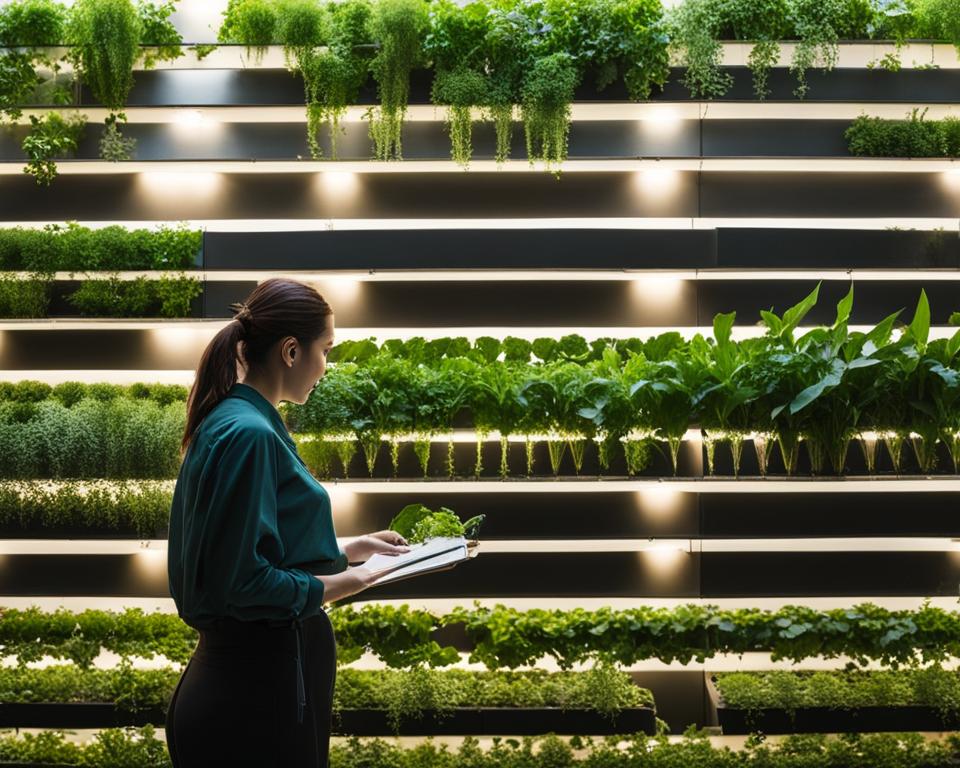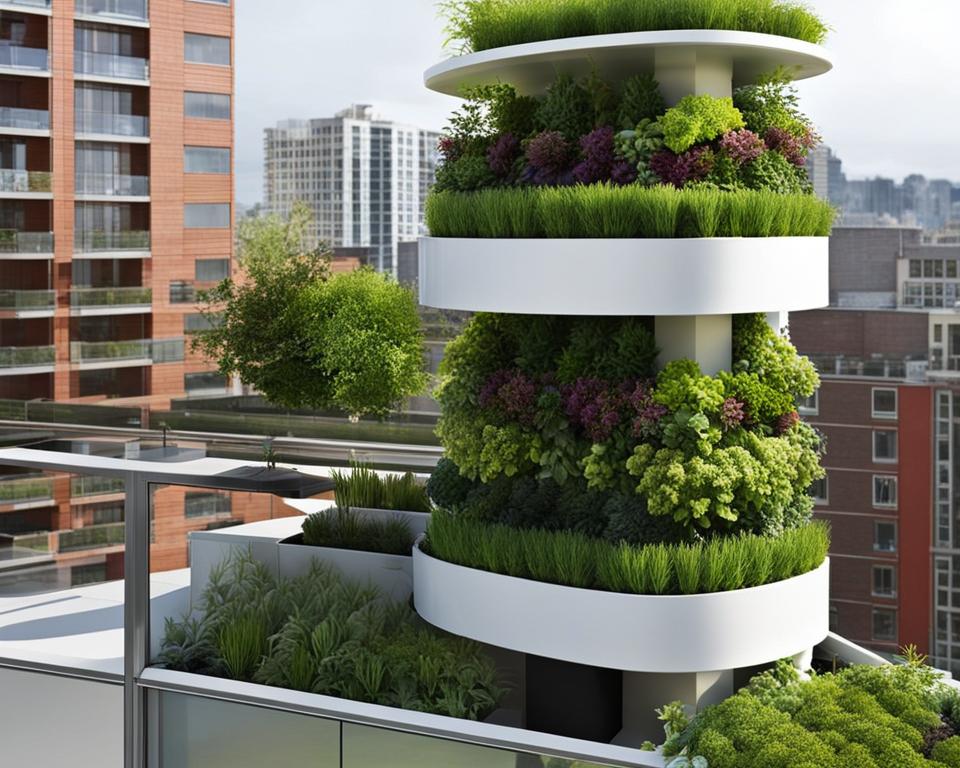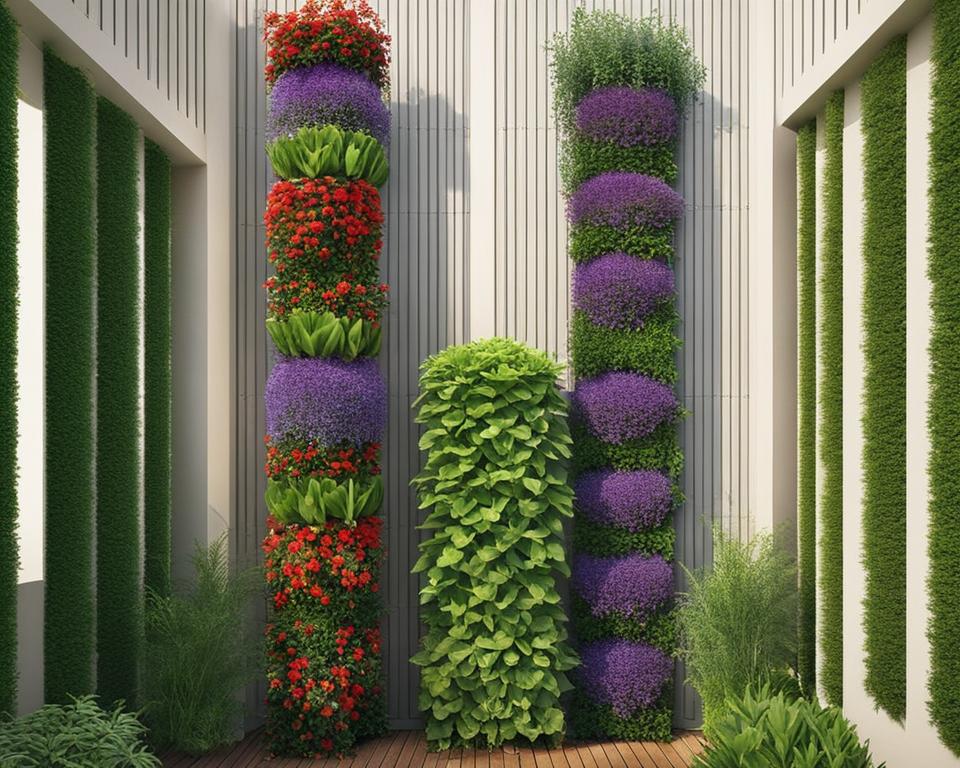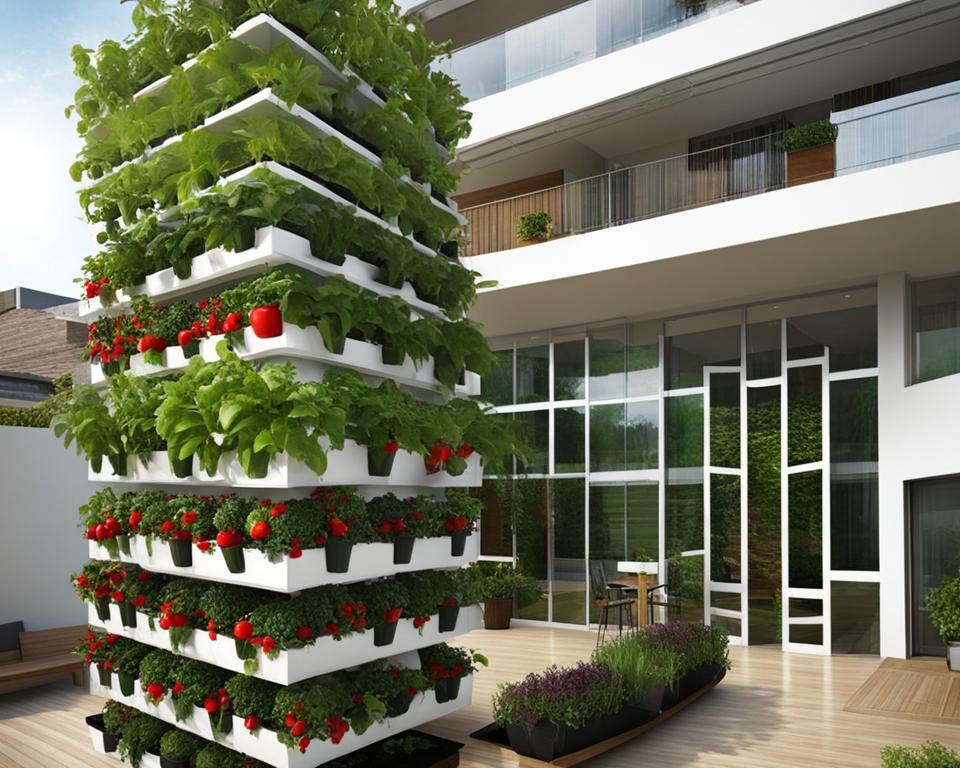Have you ever wished you could grow more plants in your limited urban space? A vertical gardening tower may be the perfect solution for you. Vertical garden towers revolutionize the concept of urban and small-space gardening by allowing you to grow a variety of plants, including herbs, vegetables, and flowers, within a compact vertical frame. Not only do these innovative gardening systems save space, but they also promote sustainable gardening by efficiently utilizing vertical space and conserving water and resources. In this article, we’ll take you through the essentials of vertical gardening and help you determine the best tower garden for your needs.
Key Takeaways
- Vertical gardening towers offer an effective solution for urban and small-space gardening.
- Grow a variety of herbs, vegetables, and flowers in a compact, space-saving gardening unit.
- Vertical garden towers are environmentally friendly and promote sustainable gardening practices.
- Choosing the right vertical gardening tower ensures optimal plant growth and productivity.
- Proper maintenance, irrigation, and soil selection ensure a thriving vertical garden.
- Vertical gardening towers can add aesthetic value to your outdoor space.
- Create a DIY vertical garden tower for a custom project tailored to your needs.
The Essentials of Vertical Gardening
Vertical gardens and vertical planters have revolutionized the world of gardening, offering a range of innovative gardening solutions to maximize the available space and yield of your garden. In this section, we delve into the basics of vertical gardens, outlining the design features of various vertical gardening systems and discussing the multiple benefits they offer.
Understanding the Concept of Vertical Gardens
Vertical gardens, as the name suggests, are gardens that grow vertically instead of horizontally. They use structures such as wall mounts, stackable planters, and vertical towers to grow plants within a limited area. This innovative approach to gardening is both space saving and efficient, making it the perfect solution for urban environments or gardens where space is at a premium.
Vertical planters are available in several designs, including stackable planters, wall-mounted planters, and vertical herb garden towers. These systems differ based on durability, ease of assembly, maintenance, and material, allowing gardeners to choose the right option based on their specific needs and preferences.
Benefits of Vertical Gardening Systems
Vertical gardening systems come with a multitude of benefits that make them an excellent choice for modern gardens such as:
- Maximizing yield: Vertical gardens can grow more plants per square foot than traditional gardens since they utilize vertical space.
- Efficient gardening: Vertical planters often require less water and resources compared to traditional gardens, making them environmentally friendly and cost-effective.
- Easy maintenance: Vertical gardening systems can be easier to maintain than traditional gardens, as they often require less weeding, pruning, and pest control.
- Space-saving: Vertical gardens allow the cultivation of plants even in tight urban spaces, making it perfect for city dwellers who want to enjoy homegrown produce without sacrificing indoor or outdoor space.
- Personalized herb gardens: Vertical gardening makes it easy to create a custom vertical herb garden tower, providing ready access to fresh herbs at your fingertips.
These benefits make vertical gardening systems an ideal choice for gardeners looking to optimize their space, enhance productivity, and reduce maintenance time and effort.
“Vertical gardens are a fantastic solution for small-space gardening. They allow you to grow a variety of plants in a compact area while maximizing yield and efficiency.”
Whether you’re a seasoned gardener or a beginner, vertical gardening systems can revolutionize your gardening experience by providing efficient, space-saving options. Consider adding a vertical herb garden tower or other vertical planters to your garden, and you’ll soon see the myriad benefits of innovative gardening solutions.
Choosing the Right Vertical Gardening Tower for Your Space

Selecting the perfect vertical planter tower for your needs can be an overwhelming task with so many gardening towers available on the market. Do not worry, though; this section will help you choose the best vertical gardening tower for your space by considering factors such as available space, mobility, material preferences, and the types of plants you wish to grow.
To begin with, assess the amount of space you have available for your new vertical garden. Consider not just the surface space but also the height, as compact gardening solutions often utilize vertical space efficiently. Measure your area to determine the maximum height of your gardening tower, which will help you narrow down options.
Tip: Don’t forget to account for potential growth and spread of your chosen plants when determining your tower’s height and size.
Next, determine if mobility is a crucial factor for you. Some vertical gardening towers come with wheels, allowing you to easily move them to different areas of your garden, patio, or balcony for optimal sun exposure or weather protection.
Material preferences are another essential aspect to consider. While some vertical planter towers are made of lightweight materials like plastic, others feature more durable materials such as metal or wood. Keep in mind that different materials come with various maintenance requirements and may affect the overall weight of the tower, which may be especially important if mobility is a key factor for you.
| Material | Pros | Cons |
|---|---|---|
| Plastic | Lightweight, affordable, low maintenance | Potential UV damage, less durable |
| Metal | Durable, weather-resistant, sturdy | Can be heavy, may rust over time |
| Wood | Visually appealing, sturdy, long-lasting | Higher maintenance, can be heavy, may rot or warp |
Finally, think about the types of plants you want to grow. Some vertical gardening towers are better suited for specific plants than others. For example, if you’re planning to grow a lot of herbs or small-leafed plants, a tower with smaller compartments might be a better choice, while larger compartments may be more appropriate for vegetables or blooming flowers.
- Herbs: Consider a tower with small compartments or pockets
- Vegetables: Opt for a tower with larger compartments to accommodate bigger root systems
- Flowers: Choose a versatile tower that can accommodate a mixture of plant sizes
In conclusion, choosing the right vertical gardening tower for your space involves considering factors such as available space, mobility, material preferences, and the types of plants you want to grow. By taking these aspects into account and assessing your specific needs, you’re on your way to finding the best vertical gardening tower for your garden!
Designing Your Vertical Garden Tower

Creating a successful tower garden for vertical gardening requires careful planning and execution. Selecting the perfect location and enhancing the aesthetic appeal of your garden are crucial aspects of the design process.
Selecting the Perfect Location
To ensure optimal growth conditions for your plants, it’s essential to choose the ideal location for vertical towers within your gardening environment. Consider the following factors:
- Sunlight exposure: Ensure your plants receive the appropriate amount of sun depending on their specific needs. Some may require full sun, while others may thrive in partial shade.
- Weather protection: Assess the location’s susceptibility to harsh weather conditions such as strong winds, heavy rains, or frost to protect your plants.
- Accessibility: Plan for easy access to the tower for regular maintenance tasks like watering, pruning, and harvesting.
Take time to evaluate your available space, noting any space constraints and optimal growing conditions, and adjust your tower garden placement accordingly.
Adding Aesthetic Value to Your Garden
A vertical vegetable gardening tower can serve both functional and aesthetic purposes. To create a visually appealing garden, follow these tips:
- Choose a tower that complements your existing garden design. If you have a modern, minimalistic garden, opt for a sleek model with clean lines. For more traditional garden styles, consider rustic or ornate designs.
- Combine plants with various textures, shapes, and colors for added visual interest. Plant flowering species alongside leafy greens and vibrant succulents to create a dynamic and inviting display.
- Strategically position your tower to visually enhance your garden layout. Place it in an eye-catching focal point or utilize the tower for garden beautification by dividing or defining specific areas.
Remember, an aesthetic garden design not only brings beauty to your outdoor space but also has the potential to improve your overall wellbeing and mood.
By carefully selecting the perfect location and adding aesthetic value to your garden, you can maximize the success and enjoyment of your vertical vegetable gardening tower.
Planting Tips for Tower Garden for Vertical Gardening

Creating a successful and healthy vertical garden involves selecting the best plants, suitable soil, efficient irrigation, and proper maintenance. In this section, we will discuss the optimal tower garden plants, vertical planter soil, and irrigation for tower gardens, as well as essential tips for vertical garden maintenance.
Best Plants for Vertical Gardening Towers
When choosing plants for your vertical garden, it is essential to consider factors such as root system size, plant weight, and growth patterns. The best plants for vertical gardening typically have shallow root systems and compact growth habits. Here is a list of excellent options for creating a diverse and vibrant vertical garden:
- Vegetables: Leafy greens, such as lettuce and spinach, and smaller varieties of tomatoes and peppers
- Herbs: Basil, chives, thyme, rosemary, and oregano
- Flowers: Petunias, marigolds, nasturtiums, and trailing varieties of annuals
Soil and Water Management in Vertical Planters
Proper soil and water management is crucial to ensure a healthy vertical garden. Selecting the right vertical planter soil and implementing an efficient irrigation system for tower gardens helps save water and resources while keeping your plants thriving. Consider these tips:
- Choose a high-quality potting mix designed for container gardening. Look for lightweight, well-draining soil that retains moisture without becoming too heavy when wet.
- Implement a drip irrigation system to ensure efficient water use. Drip irrigation systems deliver water directly to the plants’ roots, helping conserve water and keep your tower garden moist.
- Monitor your garden’s moisture levels regularly to maintain appropriate soil moisture and prevent overwatering or underwatering.
Maintaining Your Vertical Vegetable Gardening Tower
Regular maintenance is key to the longevity and productivity of your vertical garden. Here are some essential tower gardening care tips:
Maintenance tasks include regular watering, pruning, and harvesting, pest management, nutrient supplementation, and seasonal care. You will also need to monitor the irrigation system and adjust it as needed to maintain optimal soil moisture.
Stay vigilant about recognizing and addressing potential pest or disease issues. A healthy vertical garden is less susceptible to infestations and diseases, so ensure that your plants receive proper care, including adequate sunlight, appropriate water levels, and regular feeding with a balanced fertilizer.
| Maintenance Task | Frequency | Comments |
|---|---|---|
| Watering | At least 1-2 times per week | Adjust depending on weather and plant needs |
| Pruning | As needed, especially for vigorous growers | Helps maintain a neat appearance and promotes air circulation |
| Harvesting | Regularly, according to plant maturity | Prevents overcrowding and stimulates further growth |
| Pest management | Regularly inspect plants and take action as needed | Utilize organic or chemical pest control methods, depending on preference |
| Nutrient supplementation | Every 3-4 weeks | Use a balanced liquid fertilizer for container plants |
By adhering to these guidelines, you can create a vibrant, productive tower garden that maximizes your space and benefits the environment.
Conclusion
Embracing a DIY vertical garden tower comes with numerous benefits, including personal satisfaction, cost-effectiveness, and the ability to customize your vertical gardening system to suit your specific needs. Embarking on your own DIY gardening project unlocks countless possibilities for creating space-saving, aesthetically pleasing, and productive gardens in limited spaces.
As you evaluate the best vertical gardening tower options, consider the factors mentioned throughout this guide, like available space, material preferences, and the types of plants you wish to grow. By carefully reviewing and comparing different vertical gardening tower models and brands, you will ultimately find one that aligns well with your gardening goals and available space.
Whether you’re looking to enhance your current garden or start an entirely new urban gardening project, a vertical gardening tower is an innovative solution with numerous advantages. Keep in mind the importance of proper soil and water management, plant choices, and maintenance to ensure the longevity and productivity of your vertical garden. The journey to creating an efficient, beautiful, and sustainable garden is within your reach.
FAQ
What is a vertical gardening tower?
A vertical gardening tower is an innovative gardening solution that allows you to grow plants vertically, making efficient use of limited space. It is ideal for urban and small-space gardening, and can be used to grow a variety of plants, including herbs, vegetables, and flowers.
What are the benefits of using a vertical gardening system?
Vertical gardening systems offer numerous benefits, such as increased plant yield, easier maintenance, water and resource conservation, and the ability to create beautiful and functional vertical gardens in limited spaces. They are perfect for people looking to garden in small areas or those who want to enhance their current garden’s productivity.
How do I choose the right vertical planter tower for my needs?
To select the best vertical planter tower for your needs, consider factors like available space, mobility, material preferences, and the types of plants you want to grow. Evaluate different tower garden systems and choose one that aligns with your gardening goals and available space.
What is the ideal location for setting up a vertical gardening tower?
The ideal location for a vertical gardening tower should have adequate sunlight exposure, protection from harsh weather, and be easily accessible for maintenance. Consider your space constraints and evaluate the best possible location to ensure the success of your vertical garden.
What are some popular plants to grow in a vertical garden tower?
A variety of plants is well-suited for growth in vertical gardening towers, including vegetables, herbs, and flowers. Popular choices include lettuce, spinach, strawberries, basil, and petunias. Keep in mind factors like root system size, plant weight, and growth patterns when selecting plants for your tower garden.
How do I manage soil and water in a vertical planter tower?
Selecting the right type of soil is crucial in vertical planter towers. Lightweight, well-draining soil mixtures work best. Using efficient irrigation systems, such as drip irrigation or self-watering towers, can help conserve water while ensuring that your plants receive adequate moisture. Regularly check your plants’ moisture levels and manage water usage to maintain healthy plants.
How do I maintain my vertical gardening tower?
Regular maintenance tasks for a vertical gardening tower include watering, pruning, and harvesting. Pay attention to pest management, nutrient supplementation, and seasonal care to ensure your garden’s longevity and productivity. Develop a routine and regularly check on your garden to identify and address any issues promptly.
Can I build my own DIY vertical garden tower?
Yes, building a DIY vertical garden tower is a great way to create a custom gardening solution that fits your needs, preferences, and available space. It also provides a sense of personal satisfaction and cost-effectiveness. Research different designs and techniques to create a vertical garden tower that works best for your specific gardening goals.

